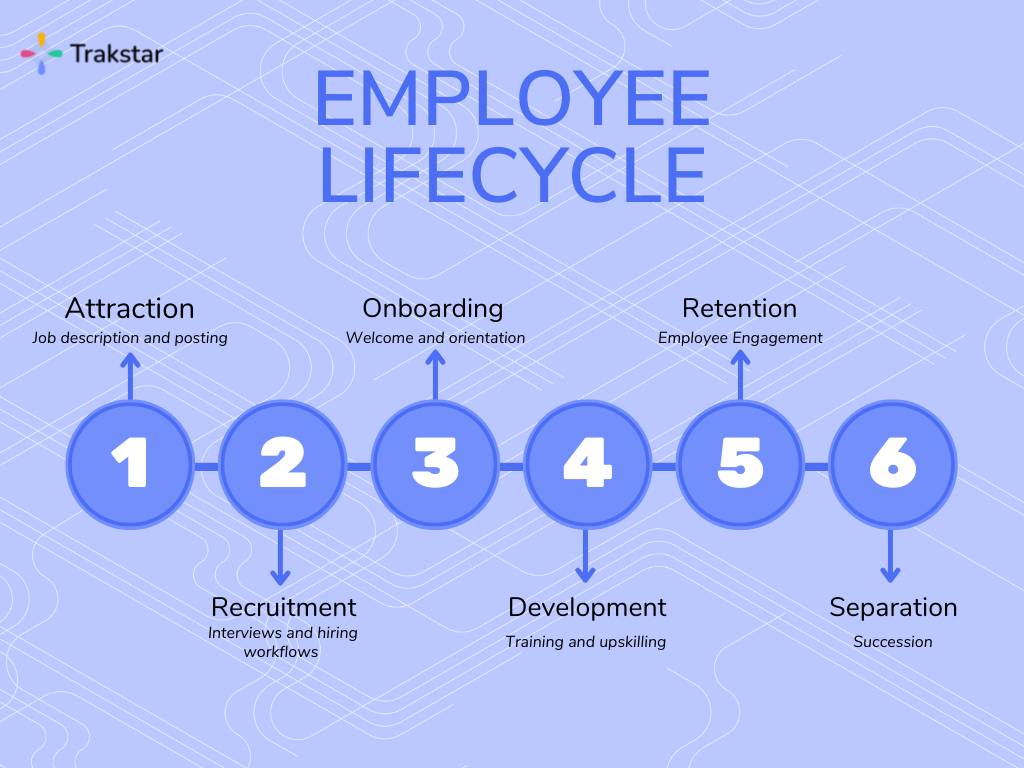Metrics To Use During The Employee Lifecycle
Posted by Trakstar • July 8, 2022 (Last modified August 23, 2022) • 6 min read
Are you using metrics to help you understand the employee lifecycle at your organization? If you aren’t, you may be missing out on key insights and information that can help you retain your best employees, predict how someone will act within your organization, and even make the experience (and your company’s culture) better for your employees.
The employee lifecycle journey is an integral part of being an HR leader and PeopleOps. You will have a leadership role during almost all lifecycle stages. You need to be prepared for anything that comes your way, including hiring struggles, justifying your work, and even showing off what you’ve done to your boss. How can you do this? Experience helps, but metrics can give you the inside information you need to grasp what’s going on at every step of the employee experience lifecycle.
What Is The Employee Lifecycle Journey?
Anyone who manages any part of the employee journey must understand the stages of the employee lifecycle. This is the model used most commonly by HR professionals to understand what employees go through as they engage with the company. There are six specific stages involved in the employee lifecycle.
The employee lifecycle stages are:
- Attraction
- Recruitment
- Onboarding
- Development
- Retention
- Separation

Employees pass through these stages chronologically; even if they leave your company and return, they will still need to start over at the first step. If an employee is fired or leaves before completing the employee lifecycle, they may jump ahead to the sixth stage, separation.
What are these important metrics for HR leaders? Let’s take a look at some that pertain to the employee lifecycle:
Hiring Metrics During The Employee Lifecycle
How’s your hiring going? If you’re like (almost) everyone else, you’re struggling. It’s hard to find the right applicant for your openings, and then it seems like you get ghosted, or they go with another company. Why? This is one of the most challenging questions for HR leaders and recruiters.
Measuring metrics during your attraction and recruitment lifecycle stages might reveal the answer.
Insights for Trakstar Hire can help you measure your analytics on speed-to-hire, the applicant pipeline, hiring processes and inefficiencies, hiring teams, dates, job boards, job titles, and so much more. You’ll be able to see where you stand, whether you need to shorten your process, or whether you have time to be a little more thorough and impress those candidates.
Metrics For the Employee Onboarding Lifecycle
How effective is your onboarding program? Are you developing good employees or just ushering them through the first few weeks of employment and throwing them onto someone else? No one in HR wants to create an onboarding lifecycle that doesn’t work. We build them by encouraging new hires to be their best, setting the stage for success, and teaching them about the company and its culture. Still, sometimes we fall short.
It’s essential to pay attention to your onboarding plans and identify what works and what doesn’t. It won’t take many onboarding processes to understand how it’s going, but you have to track it before you can notice the trends.
By paying attention to onboarding metrics, what courses get completed, who takes the time to take them, what managers enroll their employees in what courses, and what the result is for that employee, you can build a highly efficient plan.
Metrics For Continuous Learning During The Lifecycle of An Employee
Are you upskilling and training your employees once they have settled into their roles? Development is the fourth stage of the employee lifecycle, and this helps you to keep your employees engaged and get more out of them while keeping them fulfilled in their jobs. If you are going to invest time in training and upskilling employees, you need to be able to quantify the results.
Trying to explain why you need employees to enroll in a specific course can be challenging. It takes a lot of effort to explain to employees, managers, and your supervisors why you want them to step away from their jobs and train even more than they already have – particularly when they’re doing a good job.
Monitoring metrics for continuous improvement and learning can explain why you need to do it. What metrics can you monitor?
- Engagement trends
- Course completion rates
- How upskilling impacts performance
- Whether PIP training plans have had an impact
- So much more
Learn more about Trakstar Insights for Learn by reading our blog here.
Metrics For Performance Management During All Employee Lifecycle Phases
Performance reviews are one of our most important tools for retention, course correction, and general check-ins with our employees. You need to be able to quantify what comes out of those reviews. Metrics for performance management are essential to monitoring how employees are doing and getting a “how’s the weather” view of entire departments.
When you monitor performance reviews and metrics, you can tie them back to some of the most critical stages within the employee lifecycle, namely hiring and recruitment, onboarding, and development.
If you have excellent reviews, you’ll be able to tie that back to someone who hired that person or maybe to a specific training course they took. You can also use these metrics in a performance improvement plan (PIP) to help understand where your employees should be so you can set realistic SMART goals to help them become better, more productive employees.
To learn more about performance management metrics and how you can use them, be sure to check out the replay of our “Uncover the Hidden Value of Your People Data” webinar.
Employee Lifecycle Surveys and Metrics
Are you running employee engagement surveys and acting on what you find there? Be sure to take metrics and understand their impact on your workforce! Why? It helps you to quantify the work you are doing not necessarily to the C-Suite and your bosses, but to your workforce.
When your employees understand that you’re listening to them and considering their thoughts, they are more likely to engage with your work and you. Let’s be honest: HR leaders sometimes feel like they are outsiders and that their employees are afraid of them. You might struggle to feel like you can talk to your employees. Engagement surveys are one way to do that, but you need people to think they are worthwhile. Showing metrics and statistics about what you’ve done can help do that.
Don’t know how to take action after engagement surveys? We help you here.
Need Help From An Employee Lifecycle Management System?
Employee lifecycle management and analytics will become even more critical for companies of all sizes and scopes in the near future. We have the technology, so more people will start using it. We don’t have enough employees to cover the openings we create, we aren’t engaging our employees enough, and we don’t foresee the next generation finding a company and sticking with them as workers have historically done. These analytics help you make better decisions around hiring and attracting top talent – and then doing the work to keep them throughout the entire employee lifecycle.
Tracking and evaluating these analytics can seem daunting and take a lot of time – without some help, they will. With the Trakstar platform and its built-in Trakstar Insights dashboard, you have a new and exciting way to grade your work during the employee lifecycle and see what your changes do. You can schedule a demo with our team to learn more about the Trakstar platform. We’ll walk you through how we help you attract, retain, and engage top talent, no matter the market.
Don't Miss Out on More Great HR Articles!
Subscribe to get the latest, greatest HR and Talent Development content straight to your inbox.


